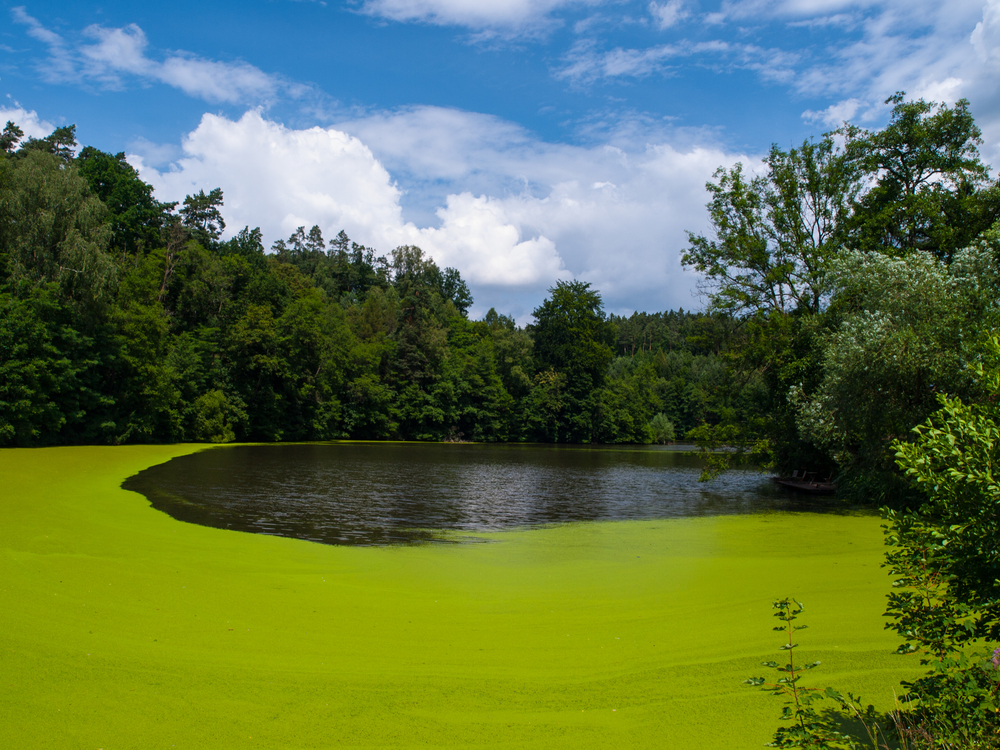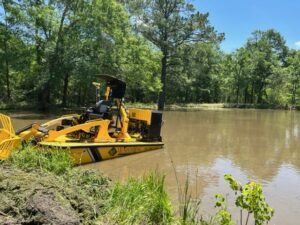Ponds, lakes, and other bodies of water frequently experience algae growth, which can have negative environmental and economic effects. Algae can worsen leisure activities like swimming and boating, damage fish and other aquatic creatures, and lower the quality of the water.
To properly prevent algae growth, it is crucial to understand its causes. The primary causes of algae growth, such as nutrient pollution, sunlight and warmth, flow and circulation, pH levels, and oxygen levels, will be discussed in this blog post. We can take steps to stop algae growth and safeguard the health of our waterways by being aware of these causes.
What causes algae growth in lakes and ponds? Learn four reasons algae may be growing in your pond or lake and what you can do to fix it. Share on XNutrient Pollution
Excess nutrients, particularly nitrogen, and phosphorus, are a primary cause of algae growth in bodies of water. These nutrients come from a variety of sources, including agricultural runoff, residential and commercial lawn fertilizers, and sewage treatment plant discharges.
When these nutrients are abundant in the water, algae can thrive and grow at a rapid pace, leading to algal blooms. This is because algae use nitrogen and phosphorus to fuel their growth, and when there is an excess of these nutrients, the algae can outcompete other aquatic organisms for resources.
Nutrient pollution comes from various sources, including agricultural runoff, lawn fertilizers, and wastewater discharges. Fertilizers and manure from farms can be washed into nearby water bodies, as well as excess fertilizers from lawns. Wastewater discharges from both municipal and individual septic systems can contain high levels of nutrients. Urban areas contribute to nutrient pollution through stormwater runoff containing pollutants like oil, grease, and pet waste.
Nutrient pollution has caused harmful algal blooms in many water bodies worldwide. Lake Erie’s algal bloom contaminated drinking water in 2014, and Florida’s Lake Okeechobee experiences recurring harmful algal blooms from agricultural runoff and wastewater discharges. Chesapeake Bay also faces reduced water clarity and oxygen levels due to harmful algal blooms from excessive nutrient inputs. These events highlight the importance of managing nutrient inputs to protect our waterways.
Sunlight and Temperature
Sunlight and temperature affect algae growth in water. Algae need sunlight for photosynthesis, so too much sunlight can cause overgrowth. Warmer temperatures can also stimulate the growth of algae, but high or low temperatures can limit it. These factors should be considered when managing algae growth.
Warm water and increased sunlight can promote algae growth in several ways. Algae require sunlight to carry out photosynthesis, which is the process by which they produce their food. Warmer water temperatures can also speed up metabolic processes, leading to the more rapid growth of algae.
Furthermore, warm water holds less dissolved oxygen, which can create conditions that favor the growth of algae over other aquatic organisms. Additionally, warm water can create stratification in lakes and other bodies of water, leading to a buildup of nutrients in the deeper layers that can fuel algal growth.
Climate change is affecting algae growth in many parts of the world. Rising temperatures in the Great Lakes region have led to harmful algal blooms. Asia has seen an increase in blue-green algae blooms due to changing rainfall patterns while warming waters in the Gulf of Mexico have created conditions for harmful algae growth. These events highlight the impact of climate change on algae growth and the spread of harmful algal blooms.
Flow and Circulation
Flow and circulation also play a crucial role in algae growth in water bodies. Strong currents or wind can cause waves, which disrupt the surface of the water and prevent algae from receiving enough sunlight for growth. In contrast, stagnant water can create ideal conditions for algal growth, as there is less disruption to the water surface and nutrients can accumulate. Proper management of water flow and circulation is essential to reduce the risk of harmful algal blooms.
Stagnant water allows nutrients to accumulate, which promotes algae growth. Flowing water limits algae growth by reducing access to nutrients and sunlight. Water movement also helps distribute oxygen, which prevents the growth of algae that thrive in low-oxygen environments. Promoting water flow is an important strategy to reduce the risk of harmful algal blooms.
Pond and lake managers have several tools at their disposal to improve water flow and circulation and prevent algae growth. One common method is the installation of aerators or fountains, which can increase oxygen levels in the water and promote circulation. Dredging or removing sediment can also help restore water flow and prevent stagnation. Additionally, creating wetlands or buffer zones around the water body can help filter out pollutants and reduce nutrient runoff, improving overall water quality and reducing the risk of harmful algal blooms.
pH and Oxygen Levels
The pH level and oxygen content of water can also affect algae growth. Algae typically thrive in water with a neutral or slightly basic pH, while very acidic or alkaline water can limit their growth. Additionally, high levels of dissolved oxygen in the water can limit the growth of certain types of algae, as they require low-oxygen environments to grow. Proper monitoring and management of pH levels and dissolved oxygen content is crucial to maintaining healthy water bodies and preventing harmful algal blooms.
Low oxygen levels and high pH can promote algae growth. In stagnant water, algae can deplete oxygen levels and cause die-offs of other organisms, further promoting algal growth. High pH levels can promote the growth of blue-green algae, which can produce harmful toxins. Proper management of oxygen and pH levels is essential to reduce the risk of harmful algal blooms.
Pond and lake managers can use aeration systems to increase oxygen levels and adjust pH with chemicals to prevent certain types of algae growth. Regular water quality testing is necessary to determine when adjustments are necessary. Proper monitoring and management of pH and oxygen levels are important in preventing harmful algal blooms.
Let Waterline Help
In summary, algae growth in ponds, lakes, and other bodies of water can be influenced by various factors such as nutrient pollution, sunlight, temperature, water flow, and circulation, as well as pH and oxygen levels. As we have seen, the consequences of unchecked algae growth can be harmful to both the environment and human health.
Fortunately, there are ways to prevent and manage algae growth through effective water management strategies. If you are interested in learning more about how Waterline can help maintain healthy and sustainable water bodies, please contact us for more information.



